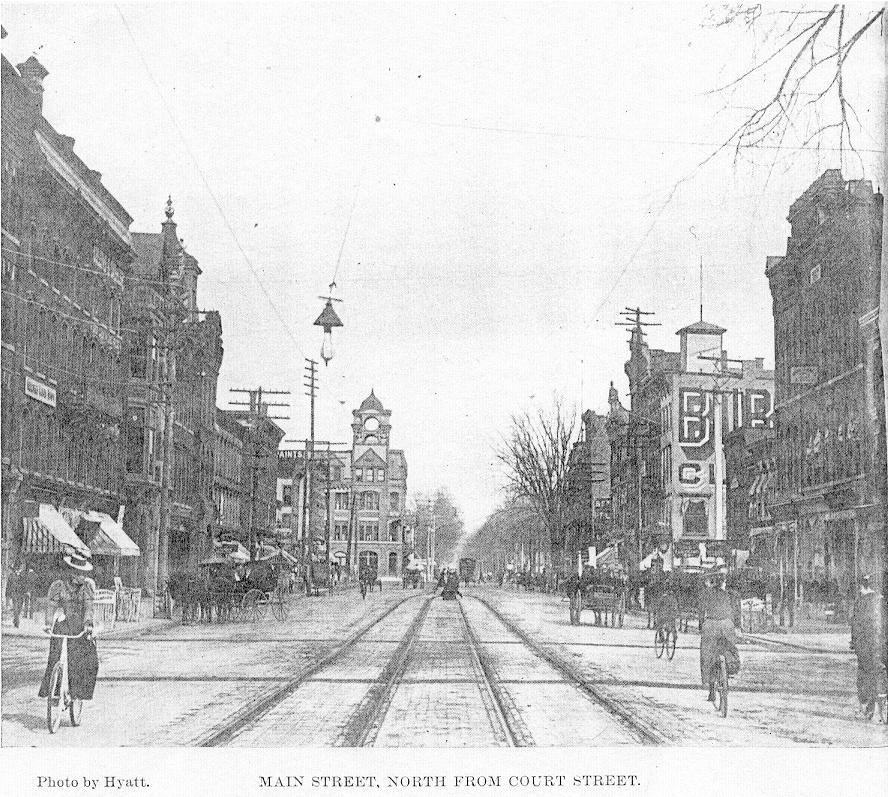

Cortland, the county seat of Cortland county, although a village in name, is a city in size, in public spirit and acquired advantages. It is situated in the beautiful valley of the Tioughnioga (bank of flowers) at nearly equal distances from Syracuse and Binghamton. At an elevation of 1129 feet above sea level, on a fertile plain formed by the confluence of seven valleys, framed by ranges of hills and ridges, which are pierced here and there by rich valleys, Cortland sits crowned with rare salubrity of climate and surrounded by a wealth of scenery of varied and surpassing beauty. The physical contour of the surrounding country makes Cortland the natural leading center of a large district. Through five of its valley are stretched railroads and two of the adjoining villages are bound to it by and excellent electric trolley system. Cortland boasts of excellent waterworks and an abundant supply of pure spring water, of a finely constructed sewer system large enough to meet the demands of a constantly increasing population of gas and electric plants with ample capacity for power and for illuminating purposes.

The fine broad streets of Cortland give ample evidence of the generosity and wisdom of their projectors and the wide stretch of fine asphalt pavement embracing nearly all the prominent streets give equal evidence of the public spirit, pride and business sagacity of the Cortland citizen of to-day.
We venture the assertion that no village of the size of Cortland can be found having such extensive asphalt paved streets, and with so uniformly fine houses and where so many residents own their own homes. In Cortland are found no tenement houses. In fact there are no poor districts, but everywhere are cheery, well kept and attractive homes. While Cortland stand confessed a great center of flourishing manufactories and an excellent mart of trade it is also a city of beautiful homes. If, as Victor Hugo says, homes are like the people that dwell in them then the homes of Cortland stand as witness of a people of rare enterprise and thrift, of commanding civic pride and high public spirit. Although Cortland is a city of business and its upbuilding has been the creation of business ventures and enterprise at no time in its history has the purely mercenary spirit possessed it. Nor have its better impulses ever been touched by the blight of wealth in the hands of ignorant self-seeking men aiming either to rule or ruin. On the contrary the people of Cortland have maintained to a marked degree their business, social and political independence. They have had a lofty and just pride in their well filled churches, in the magnificent schools and in the number and excellence of their civic, social and literary organizations. As a manufacturing center, Cortland possesses peculiar advantages and has many inducements yet to offer and not the least of these is the large available building space yet remaining, bordering the lines of railroad. Hawthorne says that if cities were built by the sound of music, then more edifices would appear to be constructed by grave, solemn tones, others to have danced forth to light fantastic airs.
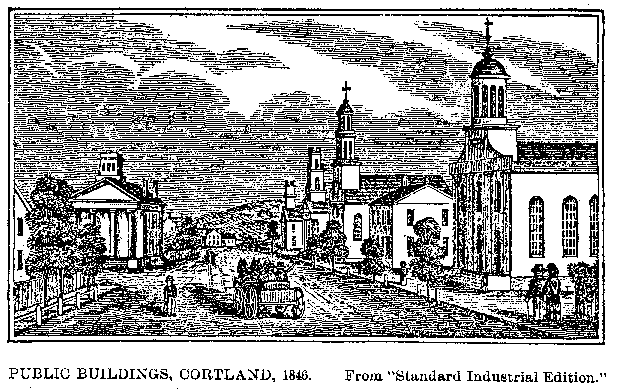
Were Cortland's edifices the creation of "the happy art" and their form and feature written out in time and tune, it would soon be discovered that the musical tones of the grace and harmony were in verity but the visible tones of ringing saw and rushing plane and the rousing chorus of the anvil and the loom.
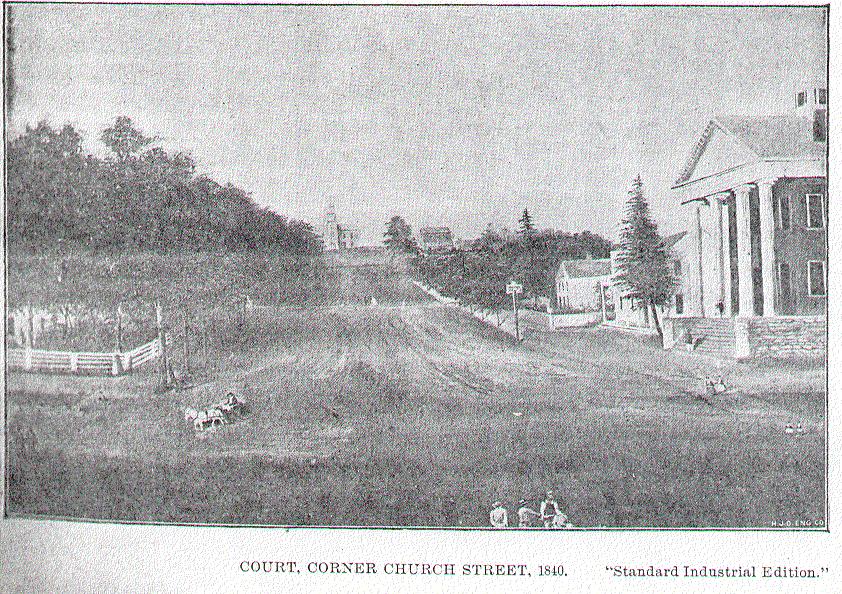
The earliest white settler within the present limits of Cortland county were Joseph Beebe, his wife, and Amos Todd, her brother. In 1791 they reared a primitive structure in the primeval forest on the banks of Tioughnioga in the town of Homer, at a point on the main road immediately north the present village of Homer. The first white settlers within the present limits of the town of Cortlandville were John Miller and family, who in 1792 erected a rude hut where now the great willow tree stands in front of the old Mason Loring place near the county house. The settlement of town of Homer, at first slow, was subsequently rapid in its development. Although in 1793 only six families had settled in the town, in 1797 the number of inhabitants had increased to 92 and the census report of 1810 shows the population of the town of Homer to be 2975. The internal improvements and developments of the town seem to have kept pace with the increasing population. As early as 1798 a schoolhouse had been built and a school opened with Joshua Ballard as teacher. In the same year a gristmill was erected, thus establishing the first trade center in the county. In 1801 two religious societies were organized, the Baptist and the Congregational. In 1808 a medical society was formed. The year 1810 was a red letter year. In that year Ephraim Fish represented Cortland county as the first member of assembly in the legislature of the state. In that year John Keep was appointed the first county judge, and in that year, after a bitter struggle on the part of Homer village, Port Watson and the village of Cortland, the site for the court house was chosen on a place now known as Court House hill in the village of Cortland, thus settling the question that the part of Homer township known as the village of Cortland should be the county seat.
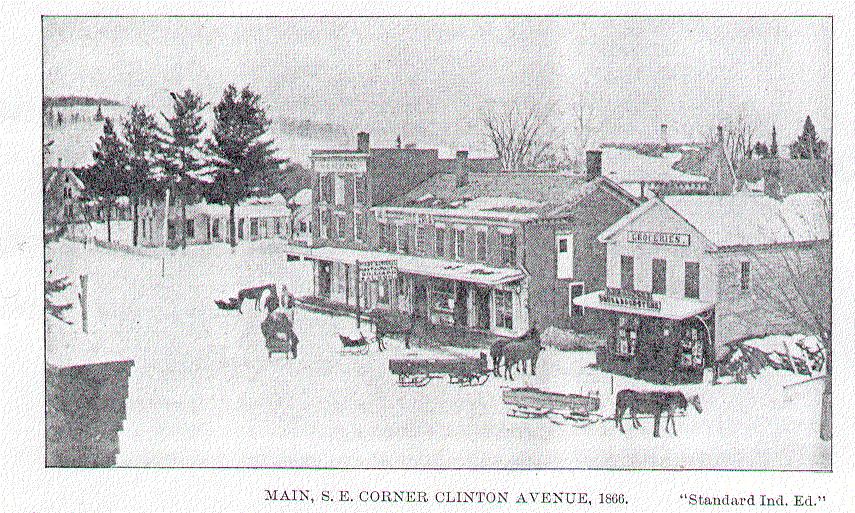
Besides these important events the year 1810 witnessed the establishment of the Cortland Courier, the first newspaper published in the county. Although a county clerk had been appointed as early as 1808, the first county clerk's office was not built till 1819 and was a quaint one-story brick structure on the site of the present county clerk's office. During the year 1815-17 there was a bitter strife involving the whole county in a controversy over locating the site of the county jail in the village of Homer. This was regard by those opposing the proposition as an initial step in the development of a scheme to change the location of the county seat to Homer. A site for the jail was finally chosen near the court house on Court House hill, and jail building was erected the following year.
In 1829 the town of Cortlandville was formed from the southern half of the town of Homer. The original boundaries of Cortlandville remained unchanged until 1845. In that year, and the following, additions were made to it from the town of Virgil. In 1836 a new court house was built and still stands, with subsequent additions on the corner of Church and Court streets. On the site of the old county clerk's office, a new structure was erected in 1876, as county clerk and surrogate's office. Nov. 5, 1853, the village of Cortland was incorporated and in 1864 was rechartered by an act of legislature.
The people of Cortland have always shown a warm interest in the cause of general and higher education. Ten years before the separation of Cortlandville from the town of Homer, the Cortland academy-now Homer academy and Union school-was chartered, and for many years was maintained at private expense and at great sacrifice but with generous liberality. One year before the separation of the towns there was founded in the village of Cortland, the Cortland village Female seminary, which maintained high rank and exerted a wide influence. The building in which the seminary was held was located on a beautiful lot facing Main street and back of the present line of the Wallace building and Taylor Hall block.
The first schoolhouse in Cortlandville stood on part of the site now occupied by the Messenger House.
In 1816 a school building was erected on a site now forming part of the Normal school ground almost directly in the rear of where the soldiers' monument stands. In this building a few years later was carried on a "Classical School for Young Men," corresponding in character and influence to the Cortland Female Seminary, both of which institutions were merged into the Cortlandville academy, which was incorporated in 1842. The Cortlandville academy was conducted in the building of the "Classical School for Young Men," with material and extensive additions thereto. During its history it was a marked success and reached high name and fame among the excellent academies of the state. Its existence terminated on the establishment of the State Normal school in Cortland. On Dec. 11, 1866, by an almost unanimous vote-only ten dissenting votes-the people of Cortland voted to the state $75,000 for the erection and equipment of a Normal school in the village. Subsequent gifts to the state for the benefit of the Normal school increased the amount to nearly $100,000.
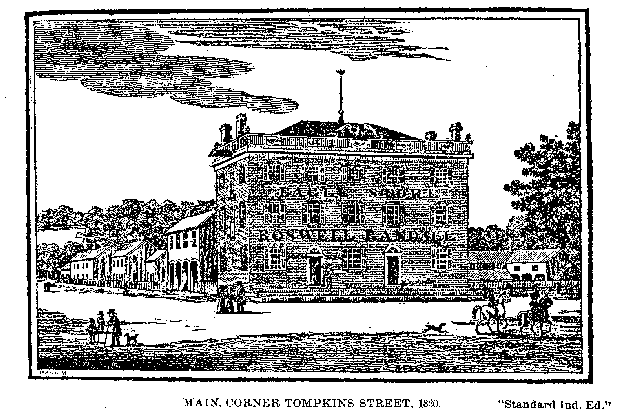
The present village school system was established in 1880 by an act of the legislature, and ward school building were immediately erected and the excellent system was completed by the erection of the present High School building in 1892.
The history of the Cortland Fire department, second to none in efficiency, dates from June 5, 1854, when the first village fire company was formed. Among the members of the fire company have been the most prominent citizens of Cortland. In 1875 was built the present handsome and convenient engine house and in 1876 was purchased a steam fire engine.
Cortland village holds a proud place in the military history of the county, which during the War of the Rebellion, sent out to the Union army the 76th regiment, four companies of the 157th regiment and three companies of the 185th regiment of N. Y. S. V., and 233 of shoes sons died on the filed of honor. The beautiful soldiers' monument erected in 1876 by popular subscription stands as a lasting memorial of heroic endeavor and of grateful remembrance.
Cortland, as has been noted, is rich in manufacturing industries. Conspicuous among the great industrial interests of Cortland are the immense works of the Cortland Wagon company, and the extensive wire factories of the Wickwire Brothers. The last quarter of a century has seen these great establishments developed from small beginnings until to-day in the quality and quantity of their outputs they are recognized among the leaders in the trade of the world.
To the following pages of the Souvenir is relegated the general and special description of the institutions, professions and organizations of Cortland. Enough, certainly, has been noted in historical description of things past to form a torch for lighting up the possible growth and achievements of Cortland and her citizens in the coming years.
The First Baptist Church was organized April 24, 1801, as the Homer Baptist church, at a meeting held at the home of Asahell Minor. On May 13 of the same year, a meeting was held at the home of E. Bishop, and three new members were received, John Morse, Mary Bishop, and Rhoda Beebe. On Aug. 28 the following resolution was passed: "Voted that we consider ourselves a church of Christ, and act accordingly," and on Oct 3 a council was called and the church as was recognized as a Baptist church. On Aug. 24, 1802, the church voted to join the Otsego association, and Thomas Keep and Peleg Babcock were appointed the first messengers to the association. When the Madison association was formed the church joined this association and remained here until the Cortland association was formed in 1823, when the church joined this association, the first meeting of which was held at Fabius, Sept. 11 and 12, 1823. The first house of worship of this church as located where Fitz avenue and Homer avenue intersect. This house was sold to the Wesleyan Methodists, who moved it to Blodgett Mills, where it was used by that society until June 4, 1890, when the First Wesleyan Methodist church of Blodgett Mills became the First Baptist church and the old meeting house with its modern improvement was again in the Baptist denomination. The church was first permitted only to have preaching occasionally. On June 19, 1802, the church voted to "support the gospel by equality" and two brethren were appointed to make out the first assessment upon the members which was as follows: Peleg Babcock $2.08; John Keep, $2.36; Joseph Beebe, 76 cts.; Cornish Messenger, 77 cts.; Daniel Crandal, 59 cts.; Roderick Beebe, 33cts.; James H. Wheeler, 13 cts. On March 23, 1802, the church voted to meet at Tully one-quarter on the time. On Nov. 19,1803, the following resolution was passed: Voted, to invite Elder Lesner to preach with us once in two months, beginning the first of October last."
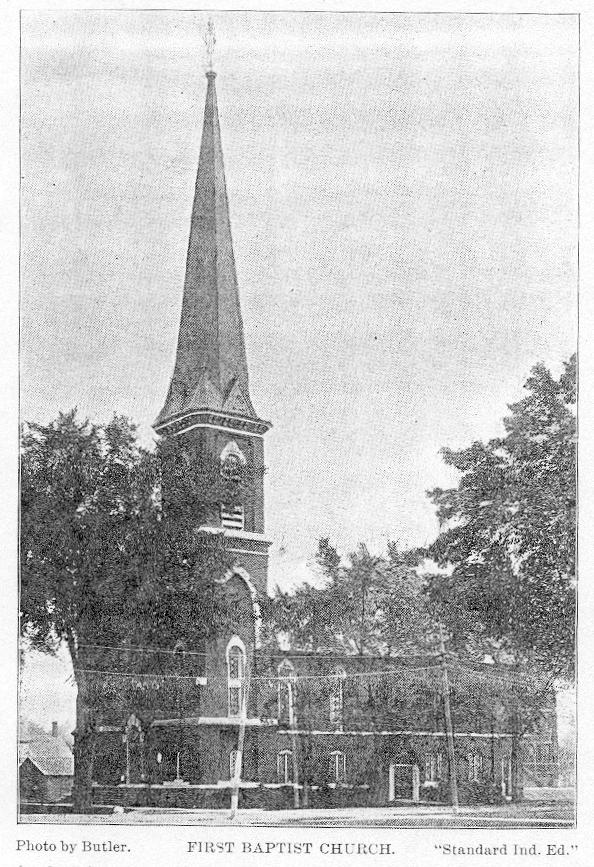
However, it was not until 1807 that the church had a regular pastor, the Rev. Alfred Bennett, who united with the church by letter, April 29, 1804, and was licensed to preach by the church, March 15, 1806, being called to the pastorate Feb. 14, 1807, and ordained June 18, 1807. The church was incorporated at Albany, June 8, 1810, as the First Baptist Society of the Town of Homer. On Dec. 8, 1830, the name of the church was changed to the First Baptist Church and Society of the Town of Cortlandville. The church has had quite an ancestral record. On Oct. 19, 1805, it voted letters to its Virgil brethren to form the Virgil Baptist church and on April 14, 1827, letters were granted to 34 members to form the Second Baptist Church of the Town of Homer, now the First Baptist Church of McGraw. On April 18, 1827, letters were granted to twenty-five members to form the Homer village church, which is now the First Baptist Church of Homer, and on Nov. 5, 1896, the church voted letters to thirty-five of its member to become constituent members of the Memorial Baptist Church of Cortland. In 1831, the church voted to build a new meeting house on Chapel (now Church street), which was constructed the following year, the contract price being $3,000.00. This was the old church that stood upon the present site, the northeast corner of Church and Railroad streets. In 1871 the church again voted to build a new house of worship and the following building committee was pointed: Chauncey Keator, H. C. Smith. E. A. Fish, Samuel Freeman, J. S. Squires, J. L. Gillett, T. M. Loring G. N. Copeland E. P. Slafter, Joseph Kinney and N. Chamberlain and as a result of the movement the present building was erected. The following pastors have served the church; Rev. Alfred Bennett, 1807-1828; Rev. Peleg Card, 1828-1830; Rev Alfred Gates, 1830-1831; Rev. Nathan Peck, 1831-1834; Rev. Zenas Freeman, 1834-1837; Rev. O. Montague, 1837-1839; Rev. J. P. Simmons, 1841-1851; Rev Henry Bowen 1851-1861; Rev. Thos Goodwin, 1861-1863; Rev A. Wilkins, 1863-1869; Rev. Wm. N. Tower, 1870-1873; Rev. Wm. M. Kincaid, 1874-1877; Rev. l. J. Mattison, D.D. 1878-1878; Rev. H. S. Westgate 1878-1880; Rev. K. W. Putnam, 1880-1885; Rev. H. A. Cordo D. D. 1885-1895; Rev. A. Chapman 1895-1899; Rev. W. Jasper Howell, 1899---. At the last Association the church reported a membership of 612. The church is now in a prosperous condition and the outlook was never brighter. --- BY ASA STARR.
Rev. W. Jasper Howell, pastor of First Baptist church, was born in Washington County, Nebraska, in December, 1870. His father was a farmer and was a native of North Carolina. His mother was a Virginian. In 1880 his parents moved to Lenoir, N.C. where they still reside. In 1890 he entered as a student a Presbyterian college in East Tennessee, the Greenville and Tusculum college. This is the second oldest college in the state. During a college revival in February 1890, he was converted and later he was a traveling salesman for some time. The proved a valuable experience, as did also his varied services as a teacher in the schools. On Jan. 4, 1891 he was baptized into the fellowship of the Baptist Church of Greenville, Tenn., by the Rev. Oscar Haywood, now pastor at Jackson, Tenn., and was licensed to preach by the Greenville church in August, 1891. In the same month he entered Wake Forest college, North Carolina, and 1892 was called to the pastorate of the Jonesboro, Tenn., church. This was one of the largest and most important churches in that section of the state. He was ordained to the work of the gospel ministry by the Greenville church November, 1893. In August, 1894, his resignation was accepted which enable him to finish his course in Wake Forest college, from which institution he was graduate in 1895, being the orator of his college society. The theme of the oration was "Christian and Patriotic Citizenship." In temperance work, in Y. M. C. A. work and as a lecturer on popular themes, Rev. Mr. Howell's convictions and sympathies have found their expressing from time to time. He has had some successful pastorates: Franklinton, N. C., Dalton N. Y., and Irondequoit, N. Y. His theological course was taken in Rochester Theological seminary, graduating in May 1899. In June he entered with bright prospects upon the labors of his pastorate in this city.
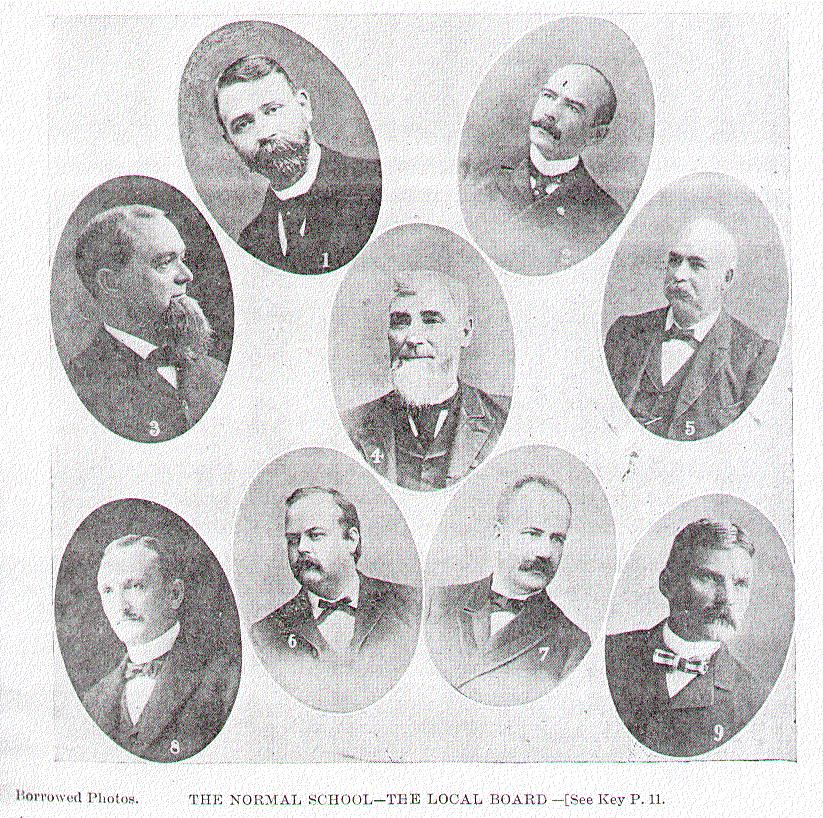
V. P. S. C. E.---In 1885 the young people of the First Baptist church organized a society called the Young peoples, association which was changed to the Young People's Society of Christian Endeavor, Oct. 12, 1886. For nearly three years, from June 30, 1889, to April 13, 1892, the society reverted to nearly its original form, calling itself the Young People's society. On the latter date it again adopted the constitution and pledge of the Christian Endeavor society, and since then has faithfully adhered to them. The society has materially assisted the church. Among many things, it has contributed liberally toward an old church debt, furnished the Sunday-school room with a carpet and piano, and provided a water motor for the pipe organ. It has sent aid to a theological student in this country and to a boys' school in China, it has furnished a room in the theological seminary at Hamilton, N. Y., and since 1895 has paid the traveling expenses of a native Burman evangelist.
Was established under the provisions of an act of the State legislature passed in 1866. By that act a commission was appointed to receive proposals with reference to the establishment Of State Normal schools from local authorities through the state, and to accept not more than four of the proposals so made. By energetic efforts and liberal pledges on the part of the people of the village, Cortland secured one of these four Normal schools. Land was acquitted and a building erected at a cost to the village of a little less than $100,000. To this was added the land and other property of the Cortlandville academy, which for a quarter of a century had done good educational service in the community and which was at that time given up under the agreement that the state should always maintain in connection with the Normal school an academic department, to which residents of Cortland might be admitted without taking upon themselves the obligation to teach.
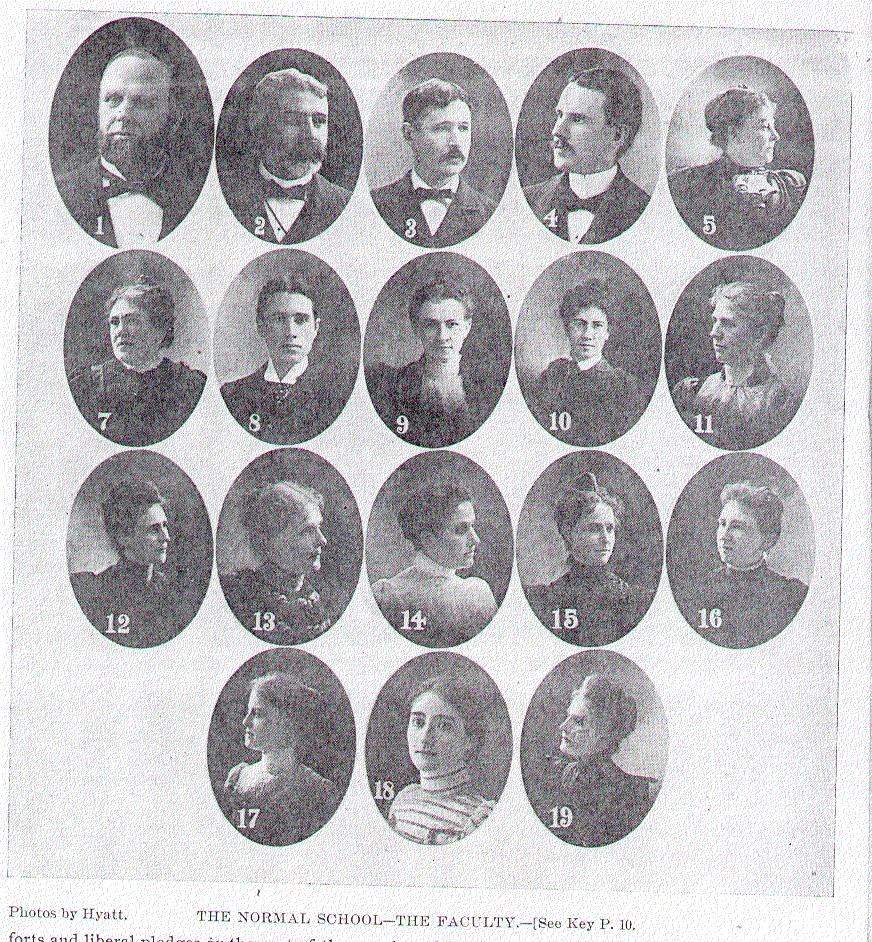
The property was accepted by the State and a local board appointed in December of 1868, and the first term of the school began in March of 1869. The original building served the purposes of the school until 1892, when the legislature appropriated $55,800 for a new building and $16,00 for the renovation of the old building. Other special appropriations for the buildings and grounds, both before and since that date, have raised the total investment of village and state in the plant of the school to nearly $270,000. The grounds contain four acres. They are well laid out and planted mainly with elms. The main entrance to the grounds is from Church street, which from the early days of the village was designed to be, as in dimensions and appearance it is a public park. The rows of elms on the greens bordering the street are of nearly a century's growth. Five of the churches of the village stand in almost consecutive order on either side of the Normal grounds, facing the street, and by their appropriate architecture add to the attractiveness of the place.
The Normal buildings are of brick. They have a total length of 350 feet and a greatest width 130 feet. They contain on all floors very nearly two acres of floor room devoted the purposed of the school. The new building is occupied exclusively by the Normal department while the laboratories and science rooms of that department are on the third floor of the old building. The first floor of the old building is occupied by the kindergarten and primary department of the training school, and second by the intermediate department. The heating through out is by a combined steam and hot air system. The heating apparatus is in a separate building, near the main building.
The furniture is all modern, different in the different departments according to the needs of the department, and the preference of the instructor. Liberal provision has been made throughout the school for maps, models, and illustrative apparatus. The chemical and physical laboratories are fitted for the purpose of offering individual instruction to students. Each has desks and apparatus for sixty students. The reference library contains about 8,000 volumes. A large room, one of the best lighted and most easily heated in the building, is given up to it and is furnished with tables and chairs to serve as a place for reading and investigation. The science and methods libraries are separate collections in their own rooms. The gymnasium is a large room, 95 x 50 feet, well equipped for work and training. The system of physical training used is the Swedish.
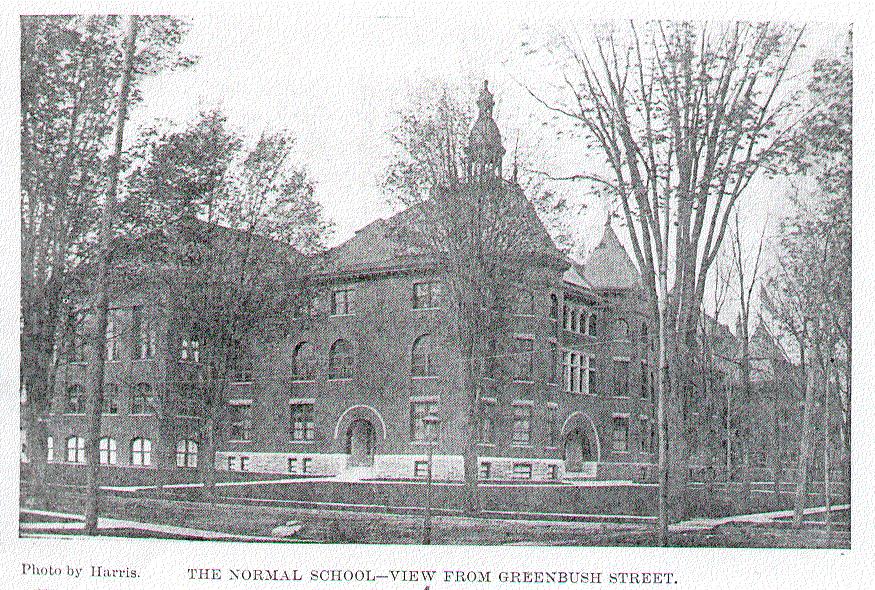
The State Superintendent of Public Instruction, Hon. A. B. Weaver, appointed the first local board Dec. 16, 1868, the first term beginning March 3, 1869. The members of the board were as they have ever since been, among the leading citizens of Cortland, some of them being men of prominence in the state. They were ex-Secretary of State Henry S. Randall; R. Holland Duell, ex-Member of Congress, ex-commissioner of Patents and Judge of Cortland County; Frederick Hyde, M. D., one of the leading members of his profession in Central New York; ex-Secretary of State Horatio Ballard; Henry Brewer, a prominent merchant of Cortland; Charles C. Taylor, Norman Chamberlain, Arnold Stafford and William S. Newkirk, prominent business men. Mr. Randall was chosen the first chairman of the board, Judge Duell the secretary and Mr. Taylor the treasurer at the first meeting, which was held Dec. 19, 1868. At the second meeting the following persons were appointed to constitute the first faculty of the school:
JAMES H. HOOSE, Principal; Metaphysics and Didactics.
NORMAN F. WRIGHT, Ancient Languages.
FRANK S. CAPEN, Mathematics.
THOMAS B. STOWELL, Natural Sciences.
MARTHA ROE, Superintendent Training School; Methods.
MRS. HELEN E. M. BABCOCK, History, Rhetoric, Geography.
MARIANNE BATES, Vocal Music.
MRS. LEMOYNE A. HOOSE, Drawing.
HELEN K. HUBBARD, Principal and Critic in Intermediate Department.
MARGARET HUNTER, Principal and Critic in Primary Department.
MARGARET A. FOWLER, Assistant in Intermediate Department.
The attendance during the first twenty weeks of school was as follows: In the Normal school, 57; training school, viz.: Academic department, 18; intermediate department 241; primary department, 267; total, 526; grand total 583. The course of study adopted at the opening of the school was the same as that then in force at the Brockport Normal school. Subsequently a uniform course was prepared an adopted by the Normal schools at Cortland, Oswego, Brockport, Potsdam and Fredonia.
The growth of the schools is well shown by the following figures: Total number of pupils enrolled for the school year 1898-9, 1,154; average attendance 1,000; number of graduates 110 -16 men and 94 women. The whole number of graduates from the beginning, 1,458-men 276; women; 1182.
Death has claimed all of the original members of the local board, Mr. Henry Brewer being the latest survivor. With the executive body are associate twenty of Cortland's prominent men. The success of the school, its equipments in every department, particularly its fine library, is the best testimonial to the faithfulness and energy of those who have so generously given their time and influence to its advancement. First chairman of the local board was Hon. Henry S. Randall, chosen, March 3, 1869; the second Dr. Frederick Hyde, chose Aug. 15, 1876; the third, Hon. R. H. Duell, Oct. 24, 1887; the fourth, Hon William H. Clark, June 8, 1891. Mr. Clark still holds the office. Mr. R. Bruce Smith and Col. James C. Carmichael have been prominently associated with this executive body.
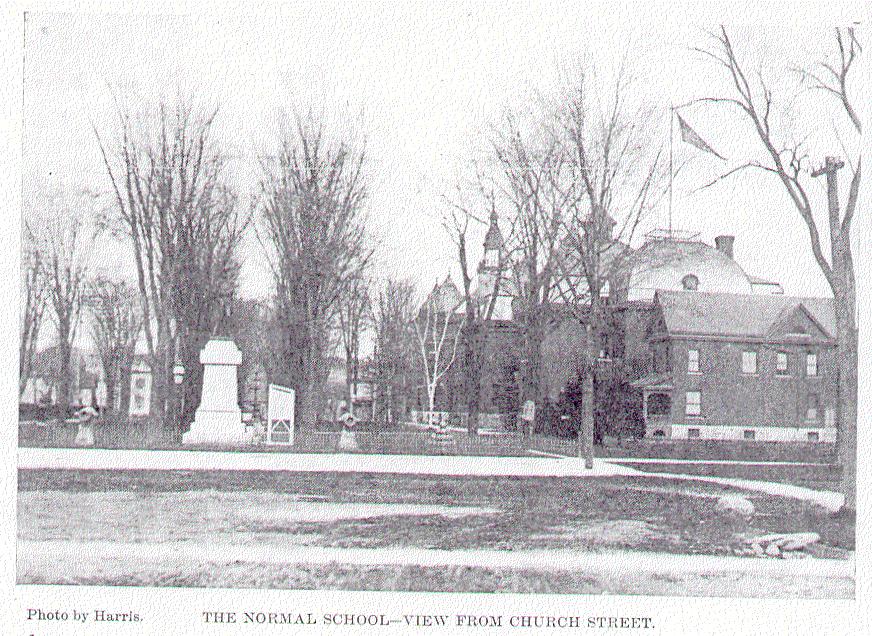
Much thought and time have been devoted to the formation of a library that should be representative not only of the technical work of a Normal school, but also of a broad culture. All barriers have been taken down and students have direct access to the shelves. The catalogue is with special reference to use by students. The name of the author, the title of the book, the subject, and in many instances the essential features of a table of contents are given in a catalogue after the manner of the Dewey card system. The library is open at all hours when the school is in session and for six hours on Saturday. Much effort is expended in promoting the intelligent use of the library by the students. List of books desirable in starting individual libraries are frequently given as well as the mention of special books that are desirable for a specialist. At almost any time when the library is open, from forty to a hundred students may be seen in it hard at work at the books.
The interest of the teachers in the social life and general culture of the students manifest itself in their helpful attention to the work of the literary societies.
There are five literary societies connected with the school: Delphic Fraternity; the Gamma Sigma-Delta Chapter; the Corloner-Alpha Chapter; the Clionian-Delta Chapter; and The Alpha Delta-Delta Chapter. The two former are for young men, the three latter for young women. These societies are each large and vigorous. Each has a large and pleasant room appropriately fitted up by its members, where weekly meetings are held for the purpose of the individual improvement of its members in parliamentary practice, discussion and literary culture.
FRANCIS J. CHENEY, Principal; Psychology and Philosophy of Education. (1)
J. EDWARD BANTA, Latin and Greek. (2)
WILLIAM A. CORNISH, Mathematics. (3)
WILLIAM M. BOOTH, Natural Sciences. (4)
MARIA W. BISHOP, Methods and Superintendent of Schools of Practice. (11)
MARY P. HENDRICK, Rhetoric, Reading, Elocution and English Literature. (5)
CLARA E. BOOTH, Physical Geography, French and German. (7)
HARRIET A. HAMILTON, History, English and Civics. (No picture.)
HELEN M. GOODHUE, Industrial Drawing. (No Picture.)
C. MONNEL CURRY, Latin and Science. (10)
MINNIE M. ALGER, Vocal Music and Methods in Music. (12)
ELIZABETH M. WRIGHT, Gymnastics and Criticisms. (15)
AMIE A. RATHBUN, Office Clerk and Bookkeeping. (9)
THOMAS J. McEVOY, Principal and Critic in Intermediate Department. (8)
HELEN E. GRIFFIN, Methods and Critic in Intermediate Department. (19)
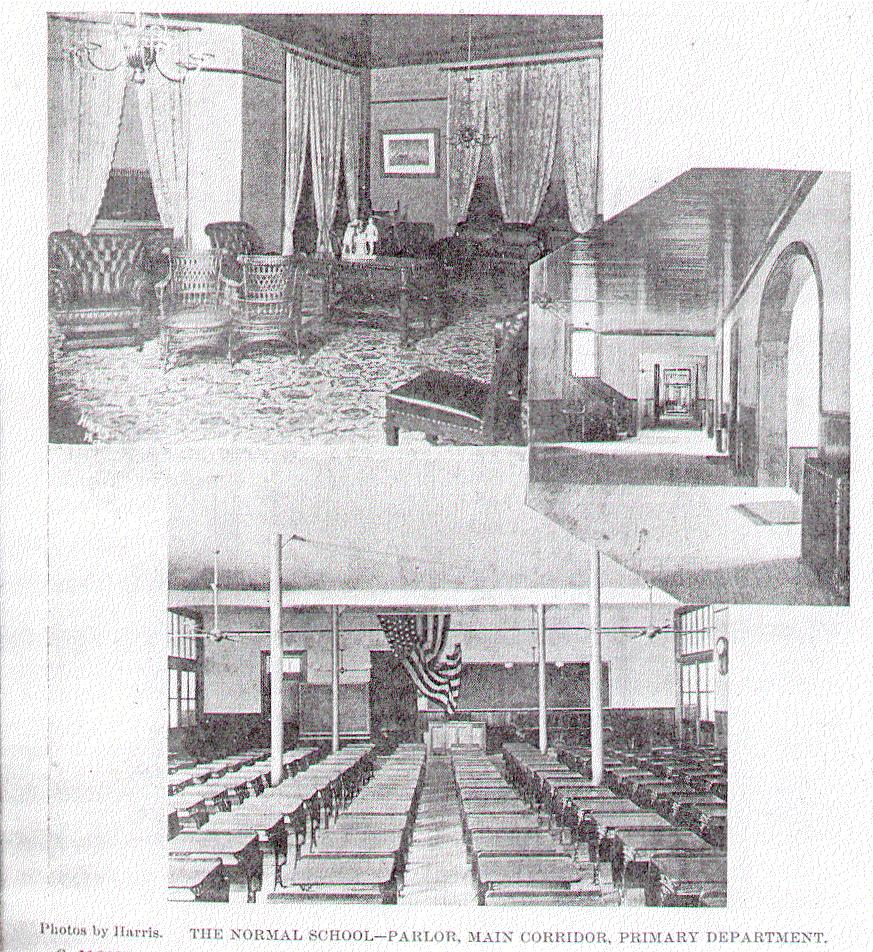
MIRIAM S. SKIDMORE, Principal and Critic in Primary Department. (14)
ELLA GALE, Methods and Critic in Primary Department. (16)
EMILY C. ORMSBY, Methods and Critic in Primary and Intermediate Departments. (13)
LILLIE H. STONE, Kindergarten. (17)
BERTHA HILL, Assistant Kindergartner. (No picture.)
MARION GOODHUE, teaching in absence of her sister Helen. (18)
WM. H. CLARK, Chairman. (1)
T. H. WICKWIRE, Secretary. (2)
L. J. FITZGERALD, Treasurer. (3)
JAS. S. SQUIRES, (4) O. U. KELLOG, (7)
HUGH DUFEY, (5) SALEM HYDE, (8)
J. W. SUGGETT, (6) ISRAEL T. DEYO (9)
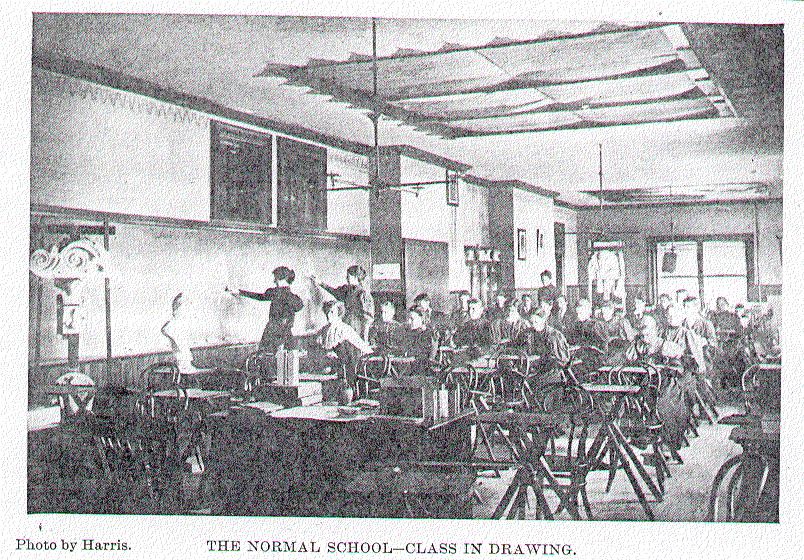
The following are the names of the members of the faculty from the beginning of the school, with date of appointment: JAMES H. HOOSE, Principal Mental Science and Philosophy of Education, March 3, 1869; NORMAN F. WRIGHT, Latin and Greek, March 3, 1869; THOMAS B STOWELL, Natural Science, March 3, 1869; FRANK S CAPEN, Mathematics, March 3, 1869; MARTH ROE, Methods and Superintendent of Training School, March 3, 1869; MRS. MARTH E. COUCH, Modern Languages, March 3, 1869; MRS. HELEN E. M. BABCOCK, History, Rhetoric, Geography until 1870, Modern Languages until July, 1872, March 3, 1869; MARIANNE BATES, Vocal Music, March 3, 1869; MRS. LeMOYNE A. HOOSE, Drawing, March 3, 1869; HELEN K. HUBBARD, Principal and Critic Intermediate Department, March 3, 1869; MARGARENT HUNTER, Principal and Critic Primary Department, March 3, 1869; CHARLES A. FOWLER, Assistant Intermediate Department, March 3, 1869; MARY MORTON, Drawing, Sept, 8, 1869; MRS. O. S. DOUGLASS, Vocal Music, Sept 8, 1869; MARY F. HALL, Critic Intermediate Department, Sept. 8, 1869; MRS. HELEN D. KENDELL, Critic Primary Department, Sept. 8, 1869; MARY F. HENDRICK Reading, Elocution, Rhetoric, English Literature, Sept. 8, 1869;
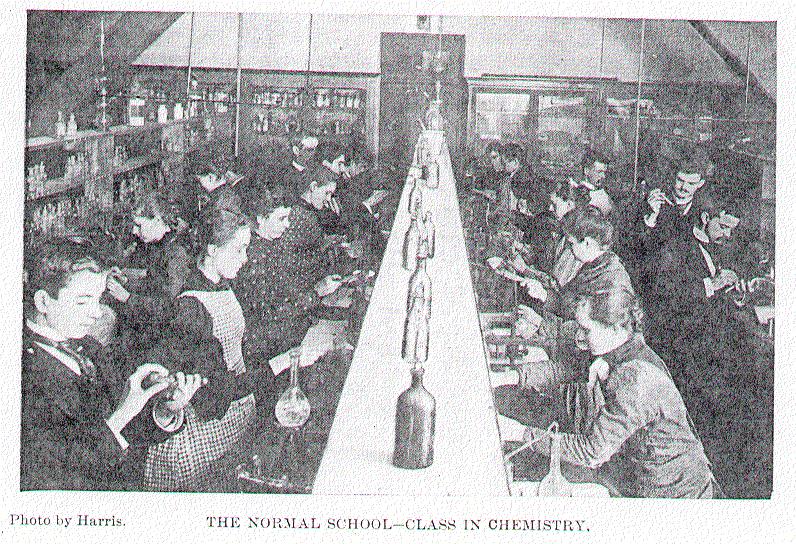
MARY MARSH, Vocal Music, Oct. 1, 1869; MRS HELEN M. SMITH, Principal and Critic Primary Department, Feb 16, 1870; AMANDA J. HOPKINS, Critic Intermediate Department until Sept. 24, 1873, then Principal and Critic same department, Aug. 1870; SARA M. SUTTON, English Grammar and History, Sept. 14, 1870; MRS THEODORE PERKINS, Principal and Critic Primary Department, Sept. 14, 1870; MARY E. LESTER, Principal and Critic Primary Department, January, 1871; JULIA H. WILLIS, Critic Primary Department, Feb. 15, 187; JAMES H. SHULTS, Principal Academic Department until Sept. 1877; then Department of English, Physics and Greek, June, 1871; EMILY E. COLE, Principal and Critic Primary Department, Feb. 14, 1872; CLARA E. BOOTH, Modern Languages, Sept. 1872; MARY A. HUBBARD, Principal and Critic Intermediate Department, Jan. 1872; HELEN. P. EELS, Critic Primary Department, Feb. 12, 1873; SARA A. SAUNDERS, Critic Primary Department, Sept. 3, 1873; HENRIETTA VAN NESS, Critic Primary Department, Sep. 24, 1873; M. AUZOLETTE DRAKE, Vocal Music and Drawing, Sept. 3. 1873; JAMES M. MILNE, Principal of Academic Department until June 27, 1876-in chair of Latin and Greek until June 18,1899-began Sept 3, 1873; MRS. E. P. HALBERT, Vocal Music and Drawing, Jan. 19,1874; SAMUEL J. SORNBERGER, English Grammar and Geography and Physics, first appointment Feb. 1874, second Sept. 4, 1878; ELIZABETH RASE, Critic Intermediate Department until Sept. 2, 1874-then principal and critic, Sept. 6, 1876; MRS. LOTTIE T. CORLEW, Critic Intermediate Department, Sept 1876; JAMES M. CASSETY, Principal, 1880-'81; GEORGE F. SAWYER Science, 1880-'81; I. T. DEYO, Science, 1880-'81; MRS. MARY L. EASTMAN, Principal Primary Department, Jan. 1883; ELLEN J. PRARNE, Critic Intermediate Department until Sept. 3, 1884; then Principal and Critic, Sept. 6, 1882; MARY L. ROBERTS, Principal and Critic Primary Department, Feb. 14, 1883; JAMES W. BEARDSLEY, Critic Intermediate Department, Sept. 3, 1884;
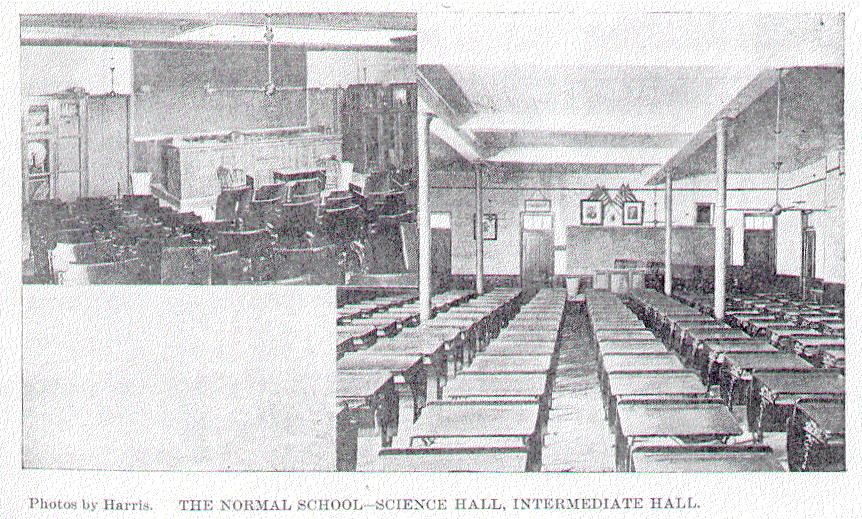
DAVID EUGENE SMITH, Mathematics, Sept. 3, 1884; IDA M. CROWELL, Critic Intermediate Department, Sept. 29, 1886; ARCHIBALD D. FREEMAN, English and Physical Culture, May, 1890; EDWARD D. BLODGETT, Latin and Greek, Sept. 4, 1889; CARRIE D. HALBERT, Vocal Music, Sept. 4, 1889; BERTHA E. JONES, Industrial Drawing, Sept. 4, 1889; HENRY MONTGOMERY, Natural Sciences, Sept. 4, 1889; MARIA W. BISHOP, Critic Intermediate Department, Sept, 1889; Methods, Sept. 1898; DARWIN L. BARDWELL, Sciences, May, 1890; FRANCIS J. CHENEY, Principal, 1891; WELLAND HENDRICK, Mathematics, 1891; MARGARET HOOKER, Drawing, 1891; THOMAS J. McEVOY, Principal Intermediated Department, first appointment, Sept. 1891, reappointed 1897; MARY L. WEBSTER, English, Sept 1893; CLARA J. ROBINSON, Methods, 1893; HELEN M. GOODHUE, Drawing, 1893; WILLIAM T. RAYMOND, Classics, 1893; MARY E. TROW, English, 1893; C. MONELL CURRY, Latin and Sciences, 1893; MINNIE M. ALGER, Music, 1893; GRACE K. DUFFEY, Principal Intermediate Department, 1893; J. EDWARD BANTA, Classics, 1893; WILLIAM A. CORNISH, Mathematics, 1893; JULIA A. NORRIS, Physical Culture, 1895; MABEL C. HURD, English, 1895; ELLA GALE, Critic Primary Department, 1895; EMILY ORMSBY, Critic in Intermediate and Primary Departments, 1895; HARRIET A. HAMILTON, English, 1896; KATHARINE G. ATKINSON, Physical Culture, Sept. 1897; LILLIE H. STONE, Kindergarten, Sept. 1897; IDA M. SHAPER, Principal and Critic Primary Department, Sept. 1897; AMIE A. RATHBUN, Office Clerk and Bookkeeping, Sept. 1898; MRS. ANNA M. NEWKIRK, Sept. 1898; WILLIAM M. BOOTH, Sciences, March 1898; MIRIAM S. SKIDMORE, Principal and Critic Primary Department, Sept. 1898; BERTHA HILL, Assistant Kindergartner, Sept. 1899; HELEN E. GRIFFIN, Methods and Critic Intermediate Department, Sept. 1899.
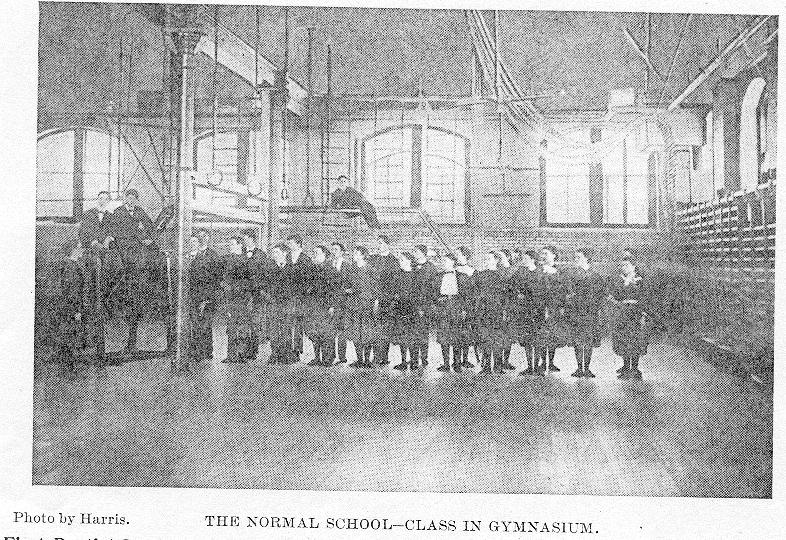
First Baptist Sunday-school was organized in 1833 under the pastorate of Rev. Mr. Freeman. Mr. Sanders, Mr. Stiles and Mr. Harvey Wood were among the early superintendents. In 1861 Deacon E. A. Fish was elected superintendent, which office he filled in a very satisfactory manner for twenty-five years. After Mr. Fish resigned, Prof. E. C. Cleaves was elected and his resignation after eight years of service was accepted with regret. Mr. Frank A. Phelps at the end of three years resigned, and Mr. Miles J. Peck, chosen for the position, is still holding that important office with marked success. The school numbers at the present time 483, including 31 teachers and 17 officers. There is a large and interesting Baraca class, Dr. F. D. Reese, teacher, and the pastor, Rev. W. J. Howell, has recently organized a class of men which numbers nearly 50 members. Mrs. C. E. Harmon has been a faithful and eminently successful teachers in the School for the remarkable period of thirty consecutive years.
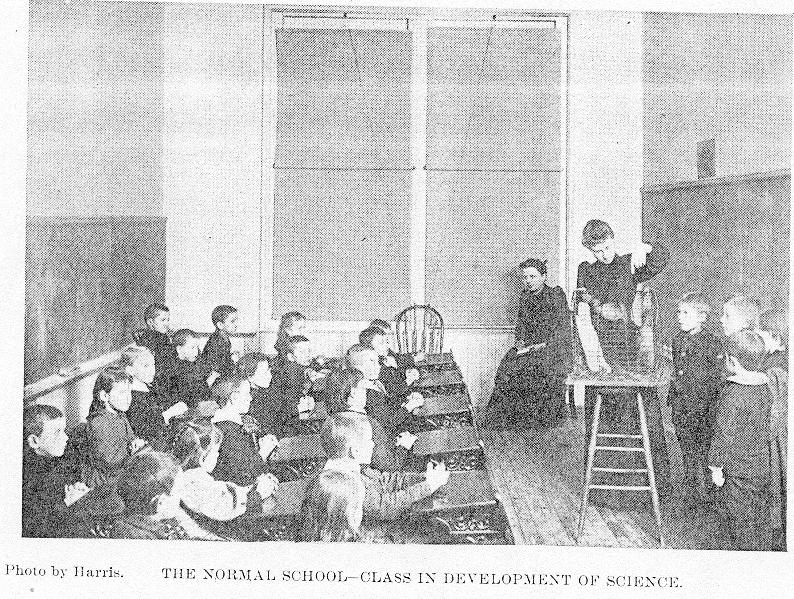
Others have long been active workers in the school, among whom are Miss Robertson, Mrs. Slafter, Mrs. Beardsley, Mrs. Cleaves. The Home department is large and flourishing under the direction of Miss Ellen Terry. The primary department numbers 106, including 7 teachers and 2 officers, and is conducted by Mrs. A. D. Ellsworth. Mr. B. L. Bentley is pianist and Mr. J. B. Hunt chorister. The average attendance is good and the school in a prosperous condition.
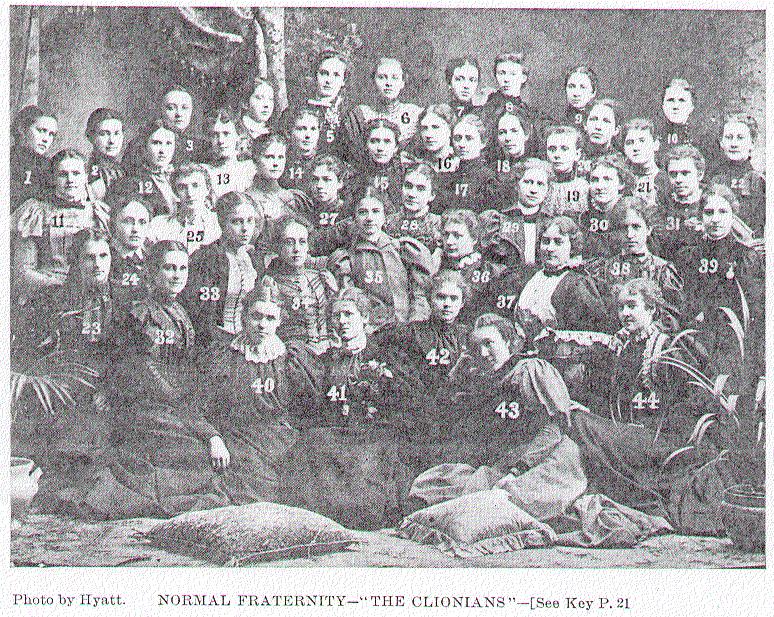
The Clionian Fraternity--The first chapter of the Clionian Fraternity, the Alpha, was formed in 1872 at Geneseo. After the opening of the Oneonta Normal, at the suggestion of their principal, Dr. Milne, the young ladies wishing to form a literary society, wrote to Alpha Chapter, asking the privilege of becoming Beta Chapter of the Clionian Fraternity. The request was granted and the first step was thus taken toward forming a Normal School Fraternity. Chapters were added from time to time until at present they number seven-Alpha at Geneseo, Beta at Oneonta, Gamma at Cortland, Delta at Plattsburg, Epsilon at Jamaica, Zeta at Mansfield, Penn., Eta at New Paltz. Gamma Chapter had existed for some time under the name of AthenŠ, but in 1890 it took upon itself the vows of the Fraternity, and has since paid loyal tribute to the shrine of Clio.
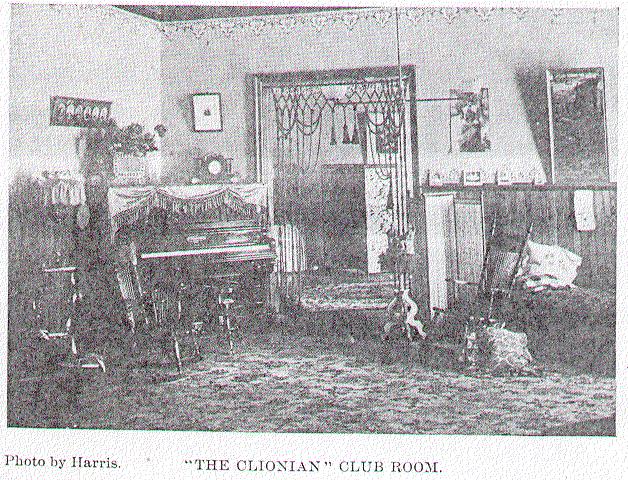
At present it has an active membership of thirty-seven with one hundred and eighteen alumnŠ. The work pursued is purely literary, and many devotees of Clio have come into closer touch with the best writers and thinkers of all ages through faithful study in this society. Meetings of the chapter are held every Friday evening from 7 to 9:30. The first hour is a business meeting, the last hour and a half being devoted to literary study. At the end of each fall term, an entertainment is given to the public showing the nature of the work done during the year, and it is at this time that the young ladies may be seen proudly flourishing the "yellow and white," the club colors. They may also be identified by such yells as "Clionians! Clionians! Clionians are we! A-t-h-e-n-a-e!" The club pin is in the form of a letter C, set with pearls crossed by a band of gold, containing the word "Gamma." Funds are raised by the efforts of the members, and these are used for furnishing the clubroom and meeting other expenses.
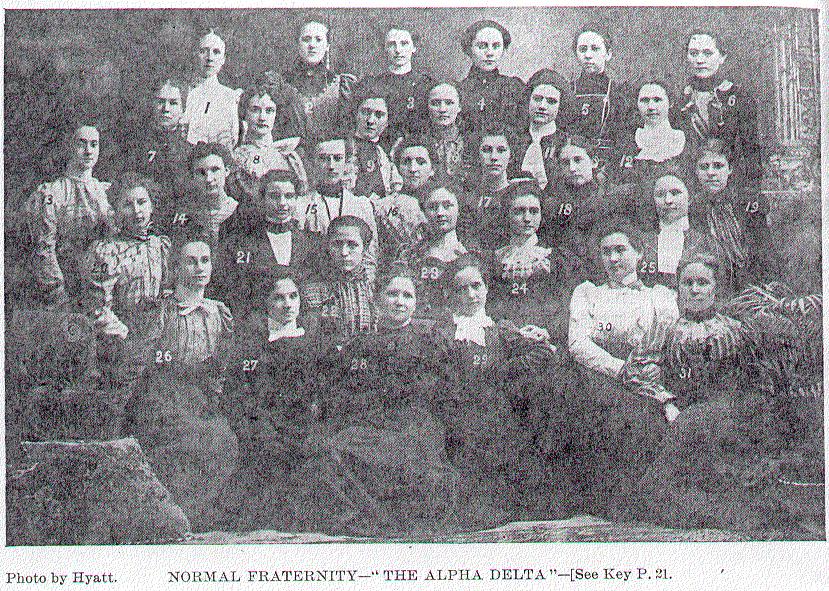
Alpha Delta--Club motto, "Time shall our laurels make more green." Through the efforts of Miss Mary F. Hendrick, a member of the Normal faculty, the delta Chapter of the Alpha Delta Sorority was organized in this school May 12, 1893. For one year the meetings were held in class room.106. Then through the kindness of the Local Board an apartment on the third floor became our permanent home.
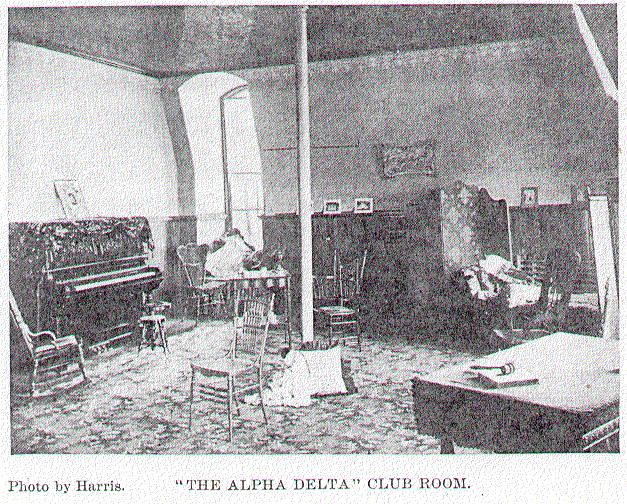
This room has been very pleasantly and artistically fitted up by the society, easy chairs and dainty tea table it presents the home-like air which is so highly appreciated by its members. The number of members at the first meeting was twenty-eight and the officers elected were as follows: President, Mary A. Winter; Vice-president, Rachael D. Gilfillan; treasurer, Olive Landon; secretary, May F. Duffey. The line of work has included the study of English and American authors with now and then a debate. Several plays have been given and six club publics which have received very flattering commendation. The club membership is limited to forty, by the constitution. It has had one hundred and twenty members and fifty graduates. Many of these are now teaching with great success in our public schools. The last two years have shown a marked increase in interest along every line of work. The membership list is now up to the limit, and all are striving to make it the most successful year in the history of Alpha Delta Sorority. The club yell for 1899: Whoop la ra! Whoop la re! Boom-a-lak, Boom-a-lak, Sol, Da, Se. Wake up! Cheer up! Ri, Ro, Re, Alpha Delta Sorority!
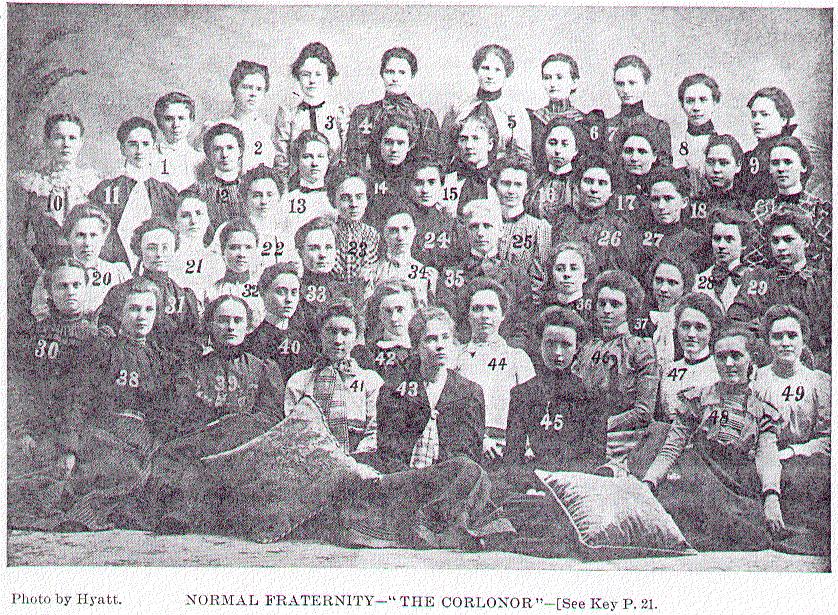
"Corlonor Fraternity"---In the fall of 1878, several enthusiastic young ladies, students of the Cortland Normal school, established "The Ladies' Normal Debating Club," which was to meet one evening of each week for the purpose of studying parliamentary drill, and discussing literary, social and political questions. For thirteen years the society prospered, sending forth to life's work strong women, capable of forming and defending independent opinions. In the winder of '91 a common constitution was agree upon with a delegation of ladies from the Buffalo Normal school and after much discussion it was decided to call the new fraternity the Corlonor. The first syllable, Cor, was derived from the word Cortland, the home of the Alpha Chapter; the second lo, from Buffalo, the Beta Chapter; the third, nor from the word Normal. During the early days of the Alpha Chapter, the meetings were necessarily held in the recitation rooms; but when the new Normal building was erected, the Local Board, recognizing the need of the rapidly growing society, generously offered the use of a large, pleasant room on the third floor, with the condition that it should be furnished by the young ladies themselves.

Each term has witnessed the addition to the already comfortable apartment of many articles, both useful and ornamental, until it is now one of the most attractive rooms to be found in the building. Through all the years of its existence the Alpha Chapter has worked side by side with its brother society, formerly, the Y. M. D. C., now Epsilon Chapter of the Delphic Fraternity, striving earnestly to help one another to attain to the highest possible type of true manhood and womanhood. Each term has witnessed a steady advancement, not only in its strength as a fraternity but in the individual improvement of its members. Each Corlonor, always loyal to the Nile green and pink, is striving onward with her noblest energies, ever mindful of her motion, "Ad Astra."
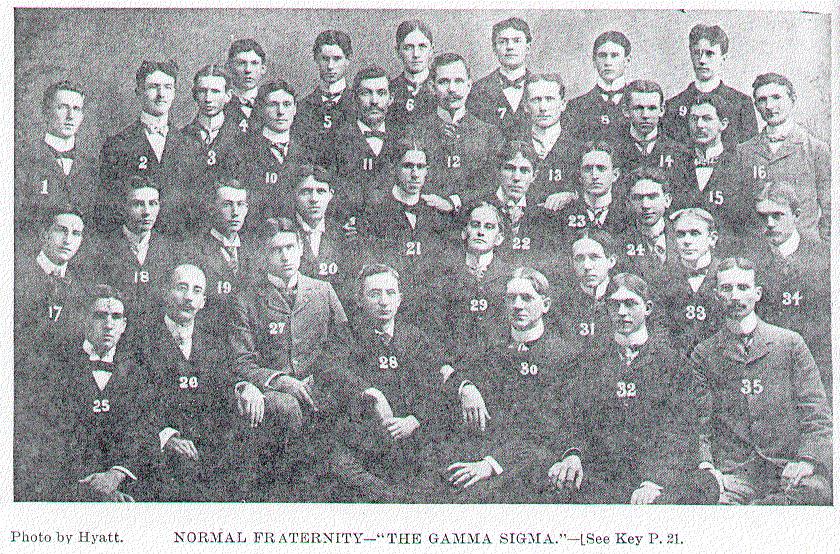
Gamma Sigma---The Delta Chapter of Gamma Sigma was formed from the old Normal Debating club Dec. 21, 1891. In September, 1870, Alton B. Parker, with eleven other Normal students formed the N.D.C. From this same N. D. C. started the Delta Chapter of Gamma Sigma Fraternity, with forty-two charter members. The first officers were: President, Sheerar; vice-president, Kales; secretary, Freeman; treasurer, Gibson; librarian, Call; critic, Van Etten. When the new Normal building was erected the Chapter moved from the old building to room 307 in the new building, which room it now occupies.
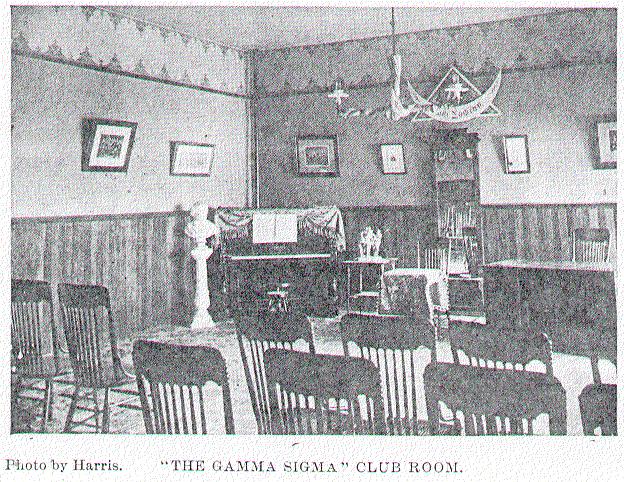
The present active members are thirty-nine. The present officers are: president, S. B. Howe; vice-president, B. Chappell; recording secretary, G. Tupper; corresponding secretary, Chas. Huntley; treasurer, M. Brown; marshal, W. West; critic, Jas. Beha.
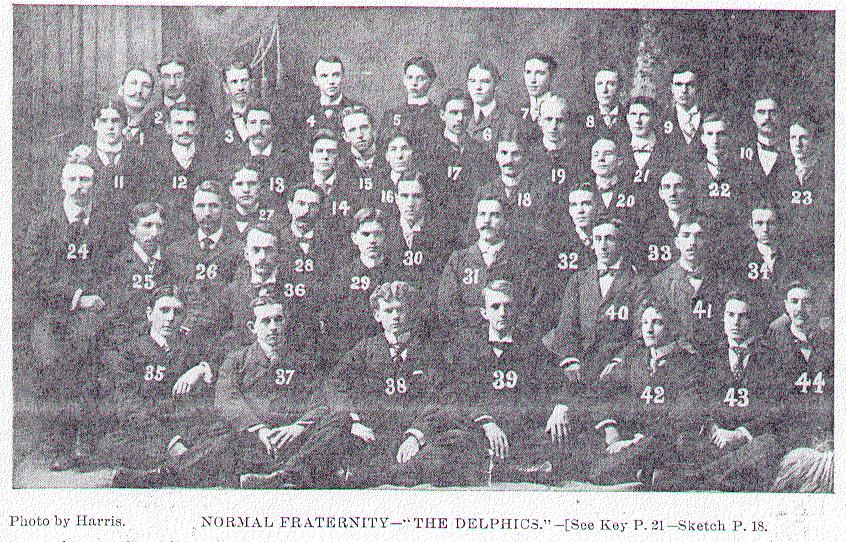
The Delphic Fraternity.---The Young Men's Debating Club, which became the Epsilon Chapter of the Delphic Fraternity in June, 1899, boasts of being one of the oldest debating clubs in the United States. Its history goes back to 1842 when the Cortland academy was one of the leading educational institutions in this section of the State. The first constitution was drawn up by James S. Squires of this village, and for many years the membership was open to girls as well as boys. Under different names, this society has maintained a distinctive rank, adapting its work to the educational and business requirements of the times. At present it supplements the regular work of the school, strengthens the bonds of friendship among its members, and endeavors to give some practical views of the broader problems of life.
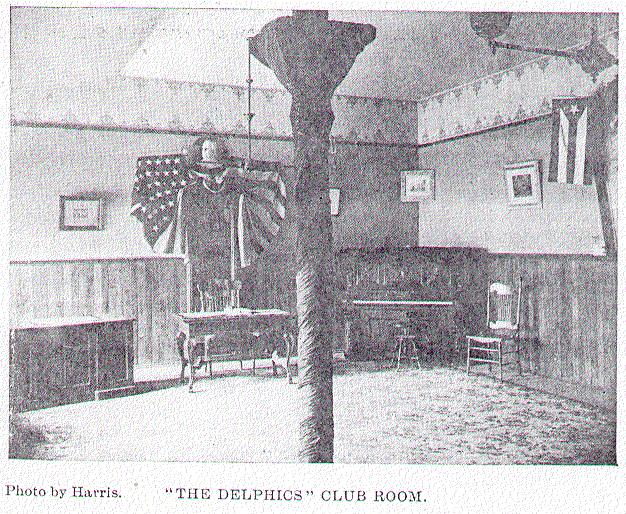
Woman's Foreign Missionary Circle---At the Cortland Baptist association of 1879, held at Groton, Miss Susie Haswell, missionary in Burma, spoke about the work among the Burman women. Two ladies from Cortland, Mrs. J. L. Gillett and Mrs. E. P. Slafter, who were present, were much impressed by her words and the pledged each other to do all they could to organize a Foreign Missionary circle. As the result, March 30, 1880, the following ladies met in the parlors of the church and organized the Woman's Foreign Missionary circle of the First Baptist church of Cortland: Mrs. Frank Capen, Mrs. J. L. Gillett, Mrs. R. P. Slafter, Mrs. E. P. Sumner, Mrs. Thomas Darby, Mrs. Oscar Purinton, Mrs. Randolph Beard, Mrs. G. W. Bradford, Mrs. Chauncey Keator, Mrs. Asa Gates, Mrs. Beman Conger, Mrs. Lewis Viele, Mrs. James W. Putnam, Mrs. Lottie Corlew, Mrs. Norman Chamberlain, Miss Emily Cole. The officers elected were: President, Mrs. J. W. Putnam; vice-president, Mrs. Thomas Darby; secretary, Mrs. E. P. Slafter; treasurer, Miss Emily Cole. At the present report (1899) there are seventy contributors and eighteen life members, besides a "Farther Lights" circle and Mission band. The present officers are president, Mrs. R. Beard; first vice-president, Mrs. J. L. Gillett; second vice-president, Mrs. Frank Haskins; third vice-president, Mrs. E. C. Cleaves; secretary, Mrs. Garry Chambers; treasurer, Mrs. F. D. Reese.
Normal Football---Football was first played by the Normal students during the fall of 1893. In September of that year the firs regular tam was organized with Rufus Corlew as captain. The suits of the then recently disbanded Forty-fifth Separate Company were purchased. Four games were played, the Normals winning two of the fours. In the fall of 1894 a number of new men appeared who did much to make the game prominent. Among them were: Harry Oday, captain of the team, Berton Landpher, Robert Welch, Herbert Knight, Clarence Miner and Harry Givens. Five games were played, the Normals winning three. The following season the team was captained by Berton Landpher. Only three of the team of the previous year had left school and their places were well filled by A. D. Brown, A. P. Robinson and W. W. Wilcox, all of whom had been substitutes the previous year. Of the six games played the Normals won four. The season of 1896 brought into the game as new men, Frank Gleason, Buy Bailey, H. F. Brooks, C. B. Dugan, Clyde Griswold and Ralph Davis. The season's score was, Normals 120 points, opponents 12; but the12 points represent one defeat for the Normals out of six games played. The team was captained by A. D. Brown. The season of 1897 found Arthur P. Robinson as captain, and on the line W. B. Patrick, W. F. Seacord, Truman Wedge, Wilford Down, W. F. Costello, Wm. Mills and Clyde Griswold. Out of six games played, the team was defeated by the Cornell Freshmen and Syracuse university. Clyde Griswold captained a team in 1808 that met with no defeat. Undoubtedly the strongest team put on the gridiron by the Cortland Normal school is that of the present year. The prestige of previous years has made it necessary to go out of our class in order to secure games. But the record of the previous year has been repeated.
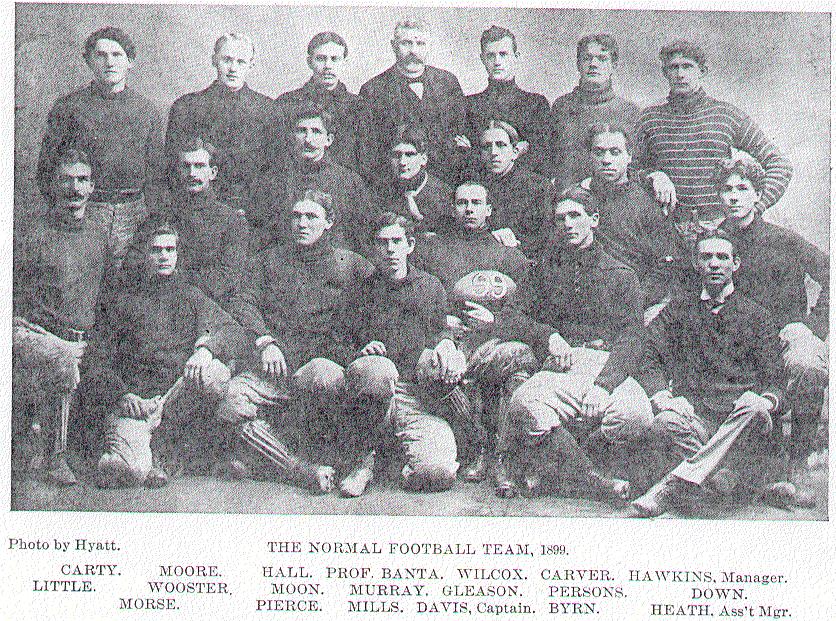
The line is composed of R. D. Hall, center; Geo. Moore and Richard Gleason, left guard; John Carty and Theodore Persons, right guard; C. M. Morse and F. Down, left tackle; W. C. Moon, right tackle; Earl Wooster and G. J. Little, left end; Wm. Mills and C. Murray, right end; R. H. Davis quarterback and captain; L. S. Hawkins left half back; F. C. Byrn, right half back; Frank Pierce and W. W. Wilcox, full back. Of the individual members it is not necessary to speak. Nor Normal team has been better captained. In the game at Athens, Byrn made a run of ninety-five yards, scoring a touchdown, and Hawkins put a touchdown to his credit after a run of eighty-five yards; while against the Mansfield team, Mills scored a touch down after a run of sixty-five yards. Of Pierce an opponent recently said, "he is the best football player in Central New York outside the college teams."
The Home Mission Society of the First Baptist church was organized May 15, 1890, with the following officers: President Mrs. D. E. Smith; vice-president, Mrs. M. M. Maybury; secretary, Mrs. C. W. Stoker; treasurer, Mrs. G. W. Bradford. The object of this society is to aid the Woman's Baptist Home Mission society. Meetings are held the last Friday in each month. Barrels of clothing are sent to missionaries to distribute as they deem best. One is now being prepared for the Home of the Friendless, New York City. Many articles of clothing are sent to the King's Daughters for distribution among the poor of our own village. The society is hoping to add one new name each year to the life membership roll. The present officers are: President, Mrs. E. H. Wilson; first vice-president, Mrs. E. O. Perry; second vice-president, Mrs. W.W. Watkins; secretary, Mrs. J. Miller; treasurer, Mrs. Wm. Pearson.
Clionian:---[Page 15.
| 1 | Jane Clark, | 23 Charlotte Cushman, |
| 2 | Nellie Wright, | 24 Grace Briggs, |
| 3 | Helena Clark, | 25 Edna Baldwin, |
| 4 | Blanche Babcock, | 26 Bessie Morgan, |
| 5 | Ruby Hagin, | 27 Bertha Powers, |
| 6 | Lottie Smith, | 28 Ethel Watros, |
| 7 | Mabel Fuller, | 29 Carolynn Kellogg, |
| 8 | Mae Fuller, | 30 Maude Carter, |
| 9 | Grace Fuller, | 31 Mable Fitzgerald, |
| 10 | May Morgan, | 32 Florence Tupper, |
| 11 | Nettie Hopkins, | 33 Jessie Hill, |
| 12 | Stella Sears, | 34 Lida Wright, |
| 13 | Grace Brister, | 35 Jane Humes, |
| 14 | Mary Grant, | 36 Alice Green, |
| 15 | Emily LaMont, | 37 Lillian Lee, |
| 16 | Alberta Waterbury, | 38 Louise Wallace, |
| 17 | Ruth Phillips, | 39 Grace Dunbar, |
| 18 | Mary White, | 40 Florence Henry, |
| 19 | Della Bates, | 41 Cora Bull, |
| 20 | Etta Rock, | 42 Harriett Strowbridge, |
| 21 | Cecil Jenks, | 43 Florence Nixon, |
| 22 | Alice Sargent, | 44 Lizzie Southworth. |
Alpha Delta:----[Page 16.
| 1 | Gale Hart, | 17 Anna Harvey, |
| 2 | Mary Northrup, | 18 Minnie Allen, |
| 3 | Ida Davern, | 19 Georgia Weaver, |
| 4 | Monett Pierson, | 20 Clara Enos, |
| 5 | Georgia Smith, | 21 Margretta Exner, |
| 6 | Nora Livermore, | 22 Alice Benham, |
| 7 | Edna Powers, | 23 Maud Chaddock, |
| 8 | Winifred Sexton, | 24 Mamie Barry, |
| 9 | Dora Mandeville, | 25 Grace Witter, |
| 10 | Miss Sherman, | 26 Olive Norris, |
| 11 | Alice Westover, | 27 Nina Seeber, |
| 12 | Ella McFarland, | 28 Olive Landon, |
| 13 | Eva Hildebrant, | 29 Fern Cooper, |
| 14 | Etta Exner, | 30 Mable Leonard, |
| 15 | Pearl Stebbins, | 31 Ella Peterson. |
| 16 | Ethel Lowe, |
Corlonor:---[Page 17.
| 1 | Jessica Paddock, | 22 Elizabeth Conway, |
| 2 | Jenny Robinson, | 23 Jennie Watros, |
| 3 | Leila Bartholomew, | 24 Mabel Hare, |
| 4 | Flora Millard, | 25 Minerva Stubbs, |
| 5 | Rosamond Robinson | 26 Ellen Norton, |
| 6 | Iva Ballou, | 27 Eva Porter, |
| 7 | Anna I. Birmingham, | 28 Evelynn Clapp, |
| 8 | Clara Tracy, | 29 Elinor Crook, |
| 9 | Alice Boyer, | 30 Mabel Abbey, |
| 10 | Florence Churton, | 31 Leona Baldwin, |
| 11 | Gertrude Snyder, | 32 Sadie Lewis, |
| 12 | Beulah Stubbs, | 33 Frances Graham, |
| 13 | Harriet Churcher, | 34 Evelyn Miller, |
| 14 | Dell Bartholomew, | 35 Miss Bishop, |
| 15 | Lena Houghtaling, | 36 Florence Chaffee, |
| 16 | Dorathea Bull, | 37 Alice Fuller, |
| 17 | Alice Hoster, | 38 Grace Burghardt, |
| 18 | Mary Kirby, | 39 Anna Pearsall, |
| 19 | Jessie Jackson, | 40 Susanna Davis, |
| 20 | Lucy Moses, | 41 Julia Sheehan, |
| 21 | Mary Per Lee, | 42 Floy Elliott, |
| 43 | Ethel McFarlane, | 47 Mattie Briggs, |
| 44 | Maude Fisher, | 48 Lula Hinman, |
| 45 | Jessie Bartholomew, | 49 Grace Hare. |
| 46 | Margaret MacLennan, |
Gamma Sigma:---[Page 18.
| 1 | Merton Brown, | 19 Lewis Bean, |
| 2 | Edw. Egan, | 20 Daniel Grant, |
| 3 | Glenn Beardsley, | 21 William Wright, |
| 4 | George Tupper, | 22 James Beha, |
| 5 | Chas. Kelley, | 23 Ralph Freeman, |
| 6 | Chas. Dowd, | 24 Earl Wood, |
| 7 | Herman Carver, | 25 Glenn Woodin, |
| 8 | Carroll Slade, | 26 Ethelbert Davison, |
| 9 | Frank Place, | 27 Benj. Chappel, |
| 10 | Leon Tarbell, | 28 Thomas Fitzgerald, |
| 11 | Fred Bierce, | 29 S. B. Howe, Jr., |
| 12 | Truman Wedge, | 30 Orris Winslow, |
| 13 | Wm. Thayer, | 31 H. Stanley Ward, |
| 14 | Frank Trapp, | 32 Chas. Otis, |
| 15 | Grove Stoyell, | 33 Chas. Huntley, |
| 16 | Floyd Atkins, | 34 William West, |
| 17 | William Halleran, | 35 Jesse Jennison. |
| 18 | Ed Vincent, |
Delphic:---[Page 19.
| 1 | Henry Ensign, | 23 Herbert Reed, |
| 2 | Stewart Dye, | 24 Chas. Dean, |
| 3 | Frank Hinman, | 25 Edw. Bingham, |
| 4 | Benj. A. Nichols, | 26 Wm. Manchester, |
| 5 | Fred Crook, | 27 Wesley Armitage, |
| 6 | Albert Gross, | 28 Edwin Preston, |
| 7 | Chas. McEvoy, | 29 Geo. Hoyt, |
| 8 | Clarence Bond, | 30 Thomas McEvoy, |
| 9 | Chas. Brownell, | 31 Archie Lindsey, |
| 10 | Clayton Sherman, | 32 Harvey Heath, |
| 11 | B. Woodward, | 33 Myron Beardsley, |
| 12 | Earl Wooster, | 34 Denera Cotton, |
| 13 | Ward Moon, | 35 Gren Bowker, |
| 14 | Chas. Morse, | 36 Fred Ward, |
| 15 | Richard Gleason, | 37 John Gleason, |
| 16 | Edgar Down, | 38 E. B. Robinson, |
| 17 | Raymond Hall, | 39 Clayton Sanders, |
| 18 | J. Gould Little, | 40 Frank Rayfield, |
| 19 | Geo. Moore, | 41 Lewis Linsey, |
| 20 | Ralph Davis, | 42 Arthur Allen, |
| 21 | Layton Hawkins, | 43 Clarence Robb, |
| 22 | Howard Milks, | 44 Chas. Smith. |
Young Woman's Christian Temperance Union.---On Oct. 9, 1897, a number of young ladies met with Mrs. Ella A. Boole, state secretary of the Y. M. C. T. U., at the W. C. T. U. rooms to consider the organization of a "Y" in Cortland. Mrs. Boole fully explained what would be expected of a "Y," and a Y. W. C. T. U. was organized with a membership of fifteen. The first president was Miss Anna L. Clarkson; second president, Mrs. Fannie H. Bierce, and third president, Mrs. Alva Caswell.
This society has met with true success in everything that has been attempted. With Christ on their side they must succeed. At present there are nineteen active and three honorary members.
You are visitor since 28 Aug 2011 -- thanks for stopping by!
There were 5410 visitors to our previous host from 3 Jun 2005 to 28 Aug 2011.
© 2005-2011